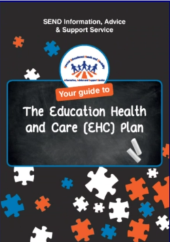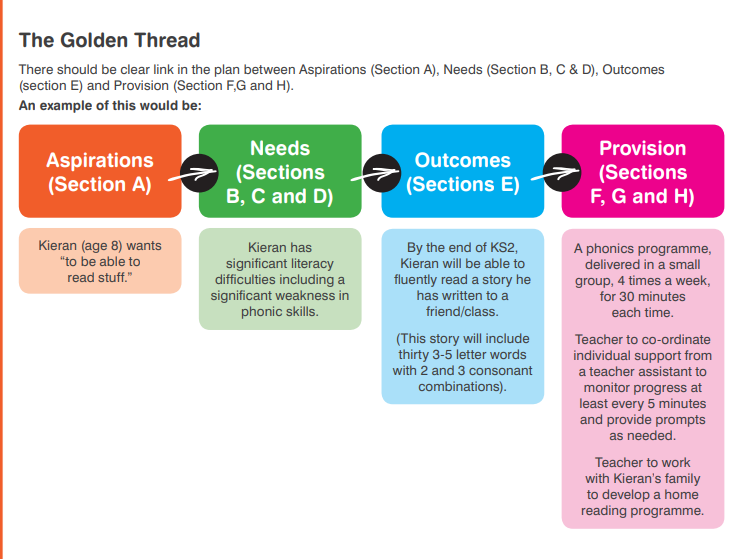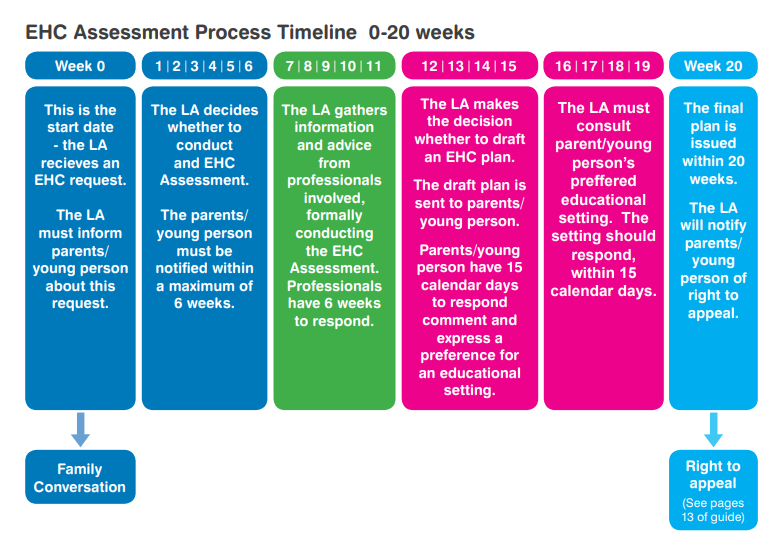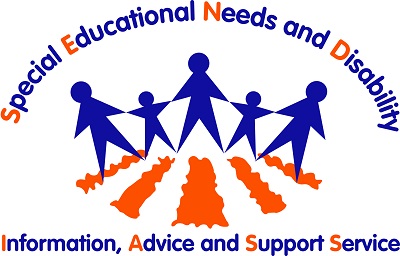Education Health and Care Plans (EHC Plans)

This page contains information on:
- What is an EHC plan?
- What must an EHCP include and how will I be involved?
- The sections of an EHCP (Sections A-K)
- The Golden Thread
- The Final EHC Plan
What is an EHC plan?
The SEND Code of Practice says:
“The purpose of an EHC Plan is to make special educational provision
to meet the special educational needs of the child or young person,
to secure the best possible outcomes for them across education,
health and social care and, as they get older, prepare them for adulthood” (9.2).
The majority of children and young people with SEN will have their needs met at ‘SEN Support’ within a mainstream educational setting. EHC Plans are for those children and young people whose needs cannot be met by the support that is usually available at their early years setting, school or college. After an EHC needs assessment has been completed and if the Local Authority decides that an EHC Plan is necessary, they will send you a draft EHC Plan, together with a copy of all of the advice and reports collected during the assessment.
The Local Authority must give you at least 15 days to respond and give your views on the content of the draft EHC Plan. During this period, the Local Authority must also make its officers available to meet with you or the young person if you wish to discuss any concerns and give your views on the plan’s content.
At this time you will also have the opportunity to state your preference for an educational setting. You also have the right to request a personal budget. All young people (those over 16 years old) with an EHC Plan, and all parents of children with an EHC plan can also ask for a Personal Budget.
What must an EHC Plan include and how will I be involved?
The SEND Code of Practice says:
“Decisions about the content of EHC Plans should be made openly and collaboratively with parents, children and young people. It should be clear how the child or young person has contributed to the plan and how their views are reflected in it.
EHC Plans should be clear, concise, understandable and accessible to parents, children and young people, providers and practitioners. They should be written so they can be understood by professionals in any Local Authority” (9.61)
The EHC Plan is split into sections A – K. We have broken down each section to help you understand what must be included (in line with the SEND Code of Practice), along with examples and “top tips” of what you should find within them.
The Sections of an EHCP
Section A: The views, interests and aspirations of the child and their parents, or of the young person
Wh at does the Code of Practice say should be included?
at does the Code of Practice say should be included?
- A brief history of the child/young person
- What the young person and their parents/carers want for the future (short term and long term)
- Details about play, health, schooling, independence, friendships
- How the child/young person communicates
Top Tips: 
- The information here should be reflected in the rest of the plan i.e. outcomes (section E) and provision (section F, G and H)
- We all have aspirations – and they often change. No-one should be limited to what they would ideally like to achieve, whether a type of job, where they’d like to live or how they participate in the community
Section B: The child or young person’s special educational needs (SEN)
A special educational need is a learning difficulty or disability which requires special educational provision.

What does the Code of Practice say should be included?
All the child/young person’s identified Special Educational Needs must be specified.
SEN may include needs for health and social care provision that are treated as special educational provision because they educate or train the child/young person (9.73)
Top Tips:
- Are the child/young person’s needs clear and easy to identify?
- Should include current levels of attainment inc. self-help skills, independence
- Is there a clear link between each need and the provision in Section F?
- ‘Content should be drawn from professional advice attached in Section K
Section C: The child or young person’s health needs which relate to their SEN
What does the Code of Practice say should be included?
The EHC plan must specify any health needs identified through the EHC needs assessment which relate to the child or young person’s SEN. Some health care needs, such as routine dental health needs, are unlikely to be related.
Top Tips:
- If there are health needs mentioned anywhere in the plan, they should be noted here e.g. sleep disorders, continence, gross motor skills
- Might their learning difficulty/disability be a barrier to health services like doctor/dentist appointments?
- A diagnosis is not a need
Section D: The child or young person’s social care needs which relate to their SEN or to a Disability

What does the Code of Practice say should be included?
- The EHC plan must specify any social care needs identified through the EHC needs assessment which relate to the child or young person’s SEN or which require provision for a child or young person under 18 under section 2 of the Chronically Sick and Disabled Persons Act 1970.
- With consent of child and parents, information about other care needs, such as Child Protection or Child in Need plan, to enable greater co-ordination of services
Top Tips:
What assessments during the EHC needs assessment were carried out to identify these needs? This will be noted in Section K. If there has been involvement from Early Help or social care, needs relating to SEN or a disability should be clearly identified in their assessments.
Section E: The outcomes sought for the child or the young person
These should be SMART: specific, measurable, achievable, realistic and time-bound.

What does the Code of Practice say should be included?
(See 9.64 for full description)
- EHC plans should be focused on education and training, health and care outcomes that will enable children and young people to progress in their learning and, as they get older, to be well prepared for adulthood. EHC plans can also include wider outcomes such as positive social relationships and emotional resilience and stability
- When agreeing outcomes, it is important to consider both what is important to the child or young person – what they themselves want to be able to achieve – and what is important for them as judged by others with the child or young person’s best interests at heart
Top Tips:
- Are the outcomes person-centered?
- “To develop literacy skills” is not person-centered or SMART.
- “Kieran will be able to read simple texts, like his favourite comic, by the end of the key stage” suggests a more person-centered approach.
Section F: The special educational provision required by the child or the young person
What does the Code of Practice say should be included?
- Provision must be detailed and specific and should normally be quantified, for example, in terms of the type, hours and frequency of support and level of expertise (of those providing it)
- Where health or social care provision educates or trains a child or young person, it must appear in this section
- Provision must be specified for each and every need specified in Section B
Top Tips:
- Is provision clearly identified?
- Phrases such as “Access to”, “opportunities for” and “regular” could be open to interpretation and as such, would not be describing specific and quantified provision.
- The duty to “secure” provision in Section F is with the Local Authority – if an educational setting cannot provide it with the funding they receive, the LA is legally obliged to do so.
Section G: Any health provision reasonably required by the learning difficulties or disabilities which result in the CYP having SEN.
What does the Code of Practice say should be included? 
- Provision must be detailed and specific and should normally be quantified, for example, in terms of the type, hours and frequency of support and level of expertise required
- Health care provision reasonably required may include specialist support and therapies, such as medical treatments and delivery of medications, occupational therapy and physiotherapy, a range of nursing support, specialist equipment, wheelchairs and continence supplies
- It could include highly specialist services needed by only a small number of children which are commissioned centrally by NHS England (for example therapeutic provision for young offenders in the secure estate)
Top Tips:
- Provision for addressing speech and language impairment is normally considered to be special educational provision and would normally be found in Section F. (See 9.73-9.76 of CoP)
- From the age of 14, all children/young people identified with a Learning Disability are entitled to an annual health check.
Section H1: Any social care provision which must be made for a CYP under 18 resulting from section 2 of the Chronically Sick and Disabled Persons Act 1970 (CSDPA)

What does the Code of Practice say should be included?
-
Provision should be detailed and specific and should normally be quantified, for example, in terms of the type of support and who will provide it
- It must outline any services assessed as being needed for a disabled child or young person under the CSDPA (examples in 9.69) or their parent/carers under the Children’s Act 1989

Top Tips:
If an assessment has not been carried out (and listed in Section K) you can request one – details of how to do this should be on the Local Offer.
Section H2: Any other social care provision reasonably required by the learning difficulties or disabilities which result in the child or young person having SEN
 What does the Code of Practice say should be included?
What does the Code of Practice say should be included?
- Social care provision reasonably required may include provision identified through early help and children in need assessments and safeguarding assessments for children but must only include services which are not provided under Section 2 of the CSDPA.
- Social care provision reasonably required will include any adult social care provision to meet eligible needs for young people over 18 (set out in an adult care and support plan) under the Care Act 2014

Top Tips:
“Reasonably required” means that LA’s can take into account cost and convenience, unlike in Section H1.
Section I: Placement

What does the Code of Practice say should be included?
The name and type of the school, maintained nursery school, post-16 institution or other institution to be attended by the child or young person and the type of that institution (or, where the name of a school or other institution is not specified in the EHC plan, the type of school or other institution to be attended by the child or young person).

Top Tips:
This should only be included in the Final plan – this section should be left blank at draft stage to give you the opportunity to state your preference for an educational setting. The Local Authority must then consult with your preference.
Section J: Personal budgets

What does the Code of Practice say should be included?
(see section 9.95 for full description)
- This section should provide detailed information on any personal budget that will be used to secure provision in the EHC plan
- The special educational needs and outcomes that are to be met by any direct payment must be specified
Top Tips:
- Any amount of money must be enough to secure the provision specified – to ensure this, provision outlined in Section F, G and H needs to be specific and quantified e.g. time, expertise of staff etc.
- If you request a direct payment to secure SEN provision delivered at an educational setting, the setting must be in agreement
Section K: Advice and information
What does the Code of Practice say should be included? 
The advice and information gathered during the EHC needs assessment must be set out in appendices to the EHC plan. There should be a list of this advice and information.

Top Tips:
- The list should include the name and role of the advice giver and the date it was given, e.g. Dr Henry Jones, Educational Psychology Service, April 2016.
- You should have a copy of all advice/information gathered during the assessment attached to the draft plan. If any important information is missing from the plan, either as a need or a provision, you should request it is included in the final plan.
The Golden Thread
There should be clear link in the plan between Aspirations (Section A), Needs (Section B, C & D), Outcomes (section E) and Provision (Section F,G and H). An example of this would be:
|
Aspirations (Section A) →
Kieran (age 8) wants “to be able to read stuff.”
|
Needs (Sections B, C and D) →
Kieran has significant literacy difficulties including a significant weakness in phonic skills. |
Outcomes (Sections E) →
By the end of KS2, Kieran will be able to fluently read a story he has written to a friend/class. (This story will include thirty 3-5 letter words with 2 and 3 consonant combinations). |
Provision (Sections F, G and H)
A phonics programme, delivered in a small group, 4 times a week, for 30 minutes each time. Teacher to co-ordinate individual support from a teacher assistant to monitor progress at least every 5 minutes and provide prompts as needed. Teacher to work with Kieran’s family to develop a home reading programme. |

The Final EHC Plan
If you or the young person has suggested changes to be made to the plan and they have been agreed by the Local Authority, the draft plan should be amended to reflect these changes and then finalised within 20 weeks of the initial request for assessment.
What can I do if I am unhappy with the final EHC Plan?
Once the final EHC Plan has been issued, the Local Authority must notify you or the young person of your right to appeal to the Special Educational Needs and Disability Tribunal (SENDIST) and the time limit for doing so. The Local Authority will also explain the requirement for you or the young person to consider mediation should you wish to appeal.
However, the first step would always be to discuss any concerns you have about the plan with your EHCP co-ordinator at the Local Authority. This is normally the person who has signed the Education Health and Care Plan.
You can find out more about this process in our "Resolving Disagreements" section




